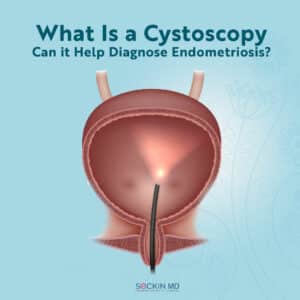What Is a Cystoscopy and Can it Help Diagnose Endometriosis?

Cystoscopy refers to the procedure of looking into the bladder using a thin camera probe called a cystoscope. The doctor uses the cystoscope to visualize inside the bladder via the urethra. Cystoscopy is an important tool in diagnosing bladder and urinary tract endometriosis (UTE).
Can endometriosis affect the bladder?
Although rare, endometriosis can sometimes affect the kidneys, bladder, and urinary tract. UTE lesions can grow either superficially on the ureter or into the bladder.
Nearly 50% of UTE cases are asymptomatic, but some patients can experience painful periods and blood in the urine. Symptoms can also include bladder irritation, urinary urgency, frequency, painful urination, and pain in the kidney area (flank).
Typically, patients with these symptoms receive misdiagnoses with diseases such as painful bladder syndrome (interstitial cystitis). However, endometriosis should be in the differential, especially if there is any correlation with menstruation.
How do doctors perform a cystoscopy?
Cystoscopies can take place in the outpatient (office) or inpatient (ambulatory / hospital) setting depending on the purpose.
In the office, you are generally awake and the doctor will apply numbing jelly to your urethra. If you receive sedation or general anesthesia, it will be necessary to have someone drive you home after the procedure.
Cystoscopy can be done using a flexible or rigid cystoscope. The doctor will gently insert the cystoscope into your urethra until it reaches the bladder. They may use a special cystoscope to collect tissue samples or to insert surgical tools and perform small procedures. They will be able to see the inside of your urethra and bladder on a monitor. Thanks to a sterile salt solution that they use to fill in your bladder, they will have better clarity.
Are there any side effects of the procedure?
For the most part, cystoscopy is a relatively low-risk procedure. There might be some discomfort immediately after a cystoscopy.
You may feel the urge to urinate as the sterile solution fills in the bladder. Post-procedural pain and burning while urinating are not uncommon in the initial days but resolve in the next few days. Bleeding is possible, but serious blood loss is very rare. Rarely, cystoscopy can cause a urinary infection requiring oral antibiotics.
How can cystoscopy help with endometriosis?
Surgery is an effective treatment option for bladder endometriosis. Cystoscopy offers a valuable diagnostic tool for bladder endometriosis.
Surgical approaches that make use of cystoscopy include:
- Transurethral surgery in which bladder lesions and 0.5-1 cm deep portions of adjacent myometrium are excised.
- Partial cystectomy which fully excises bladder endometriosis and the surrounding bladder wall while preserving bladder function.
Cystoscopy can help with surgical resection of parts of the bladder affected by endometriosis while helping preserve bladder function. The doctor may use stents during the operation to facilitate the surgery and decrease the risk of injury to the bladder and ureters. Studies have shown that cystoscopy combined with laparoscopic surgery simultaneously can be effective in the excision of bladder endometriosis while avoiding unnecessary bladder wall excision.
Have you had or are you scheduled for a cystectomy? Please share your experience with others by leaving a comment on our post on Facebook or Instagram if you wish.
Get a Second Opinion
Our endometriosis specialists are dedicated to providing patients with expert care. Whether you have been diagnosed or are looking to find a doctor, they are ready to help.Our office is located on 872 Fifth Avenue New York, NY 10065.
You may call us at (646) 960-3080 or have your case reviewed by clicking here.